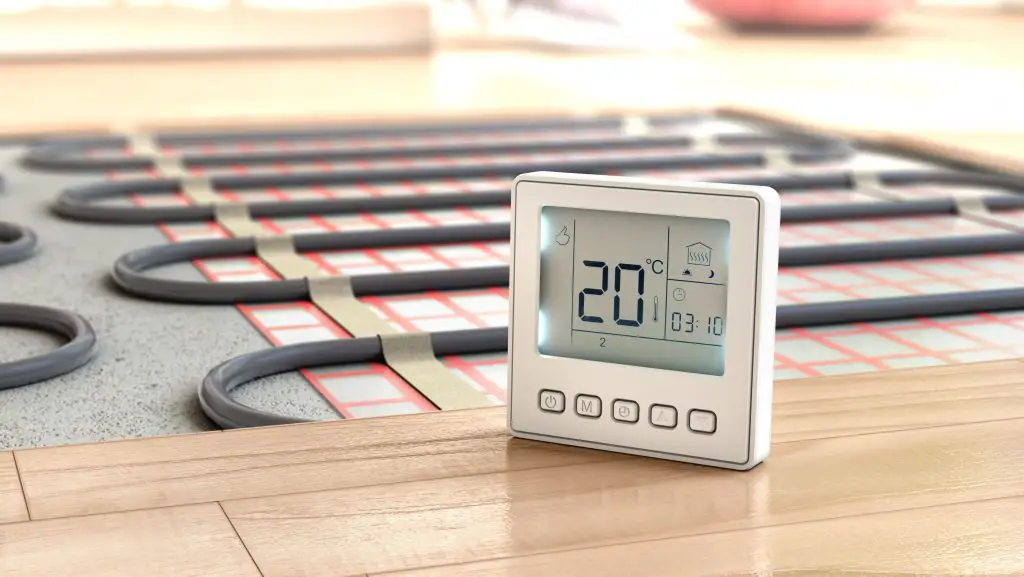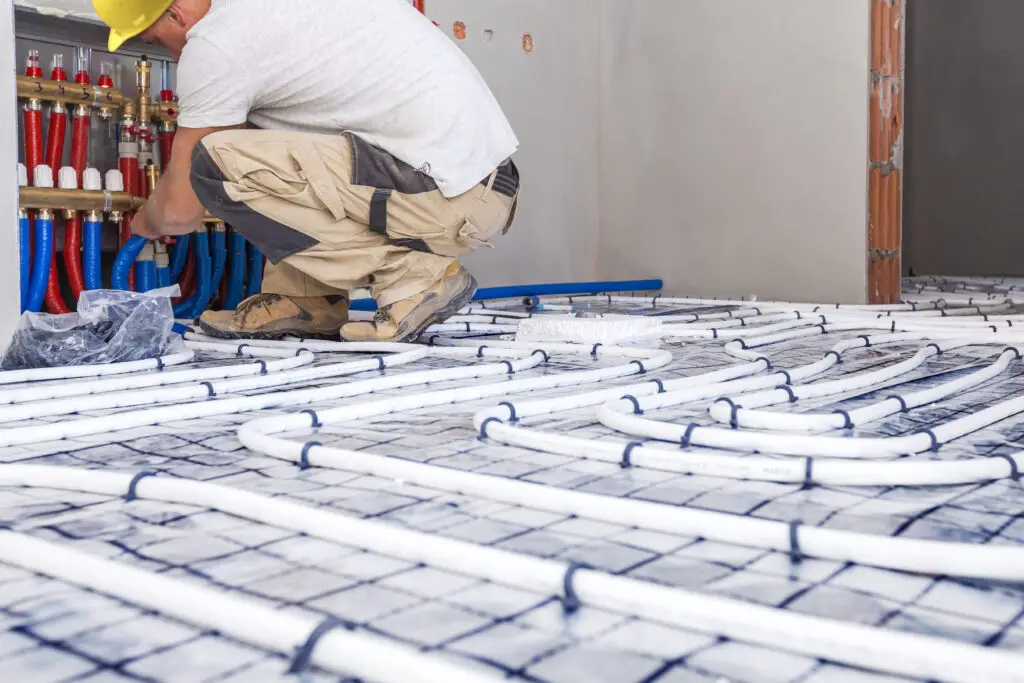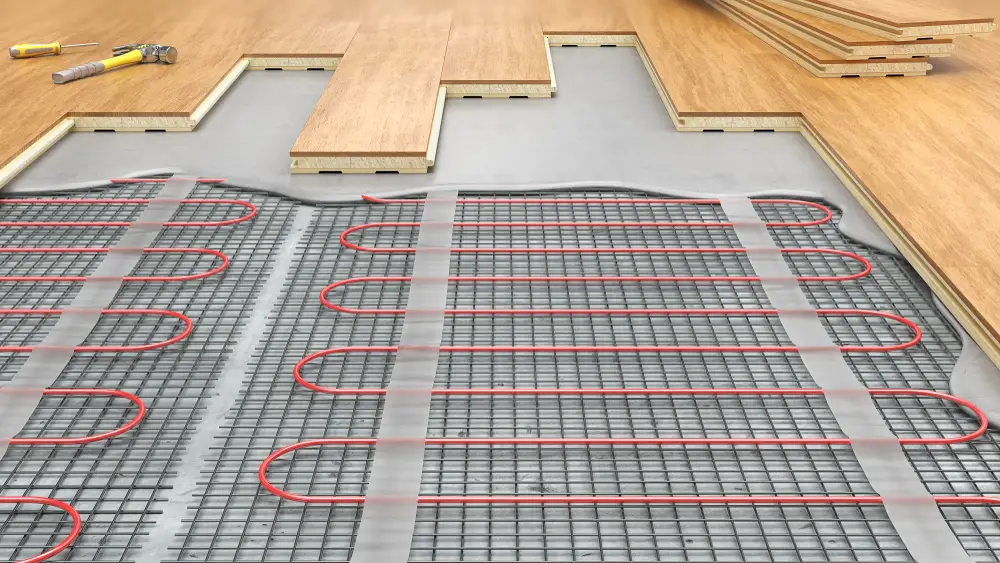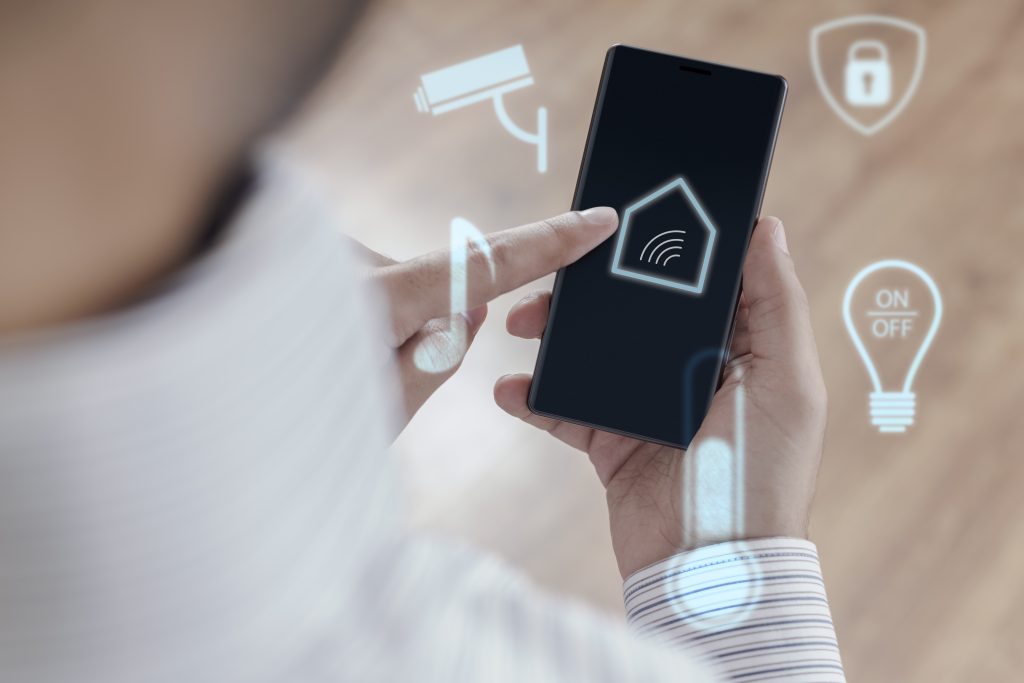When you have installed all the floors and the weather starts turning cold you may reach for your underfloor heating system at the peak of the cold. Only being left to shiver until the early morning as the heated floors are seemingly unable to work properly. Many people forget how long it should take a heated flooring to work properly, so just how long should it take for your heated flooring to warm up?
Electric Underfloor heating begins to warm up immediately, reaching operating temperature within a few minutes. Water-based underfloor heating will take up to 3 hours to reach full operating temperatures from cold. The heating elements in your floor will warm up a lot earlier than the ambient room temperature.
Knowing what the best types of underfloor heating are for your home, and how they will affect the overall temperatures that you can enjoy will greatly affect how you are using the heating system. Many homeowners that are using underfloor heating for the first time make the mistake of using them like normal heating. You must understand how underfloor heating works and what the best ways are for each type for your home.

How long does underfloor heating take to warm up? – Electric Vs Water
In the world of underfloor heating, two types of heating have become popular among homeowners around the world. Each with its own distinct advantages or disadvantages. Chief among these is the speed at which the radiant heating heats up your home.
Water based heating has been seen as the better, long-term heating for homes that are still under construction, with the heating elements requiring more in-depth construction that can be done in a home that has already been built.
While electric underfloor heating offers a versatile solution for those who wish to retrofit the heating into their homes, increasing the locations they can be used in.
The electric panels or water in the pipes will heat up to operating temperature first, then it will take additional time for this heat to radiate upwards and increase the ambient temperature of the air in your home.
The time taken for underfloor heating heat to radiate into the home is dependant on the system used, your flooring, and any screed and insulation that is used.

Water Based Underfloor Heating – Time to Warm Up
This is the largest and most complicated underfloor heating system that you can install in your home and will be the longest lasting. However, it can take several hours for underfloor heating to become effective in heating your home, with the water that may be just above freezing in the pipes having to be heated first.
Water-based underfloor heating systems can take up to 3 hours to reach operating temperatures from the point of being switched on. You can expect to feel a warm floor underfoot quite quickly but it will take an additional few hours to heat up the ambient temperature of your home.
It takes a lot less time to heat up a water-based underfloor heating system that has already been on a low setting than one that has been switched off.
Water underfloor heating needs to be started and left on for a lot longer to become effective than electrical heating, however, the benefit of this is that the water in the system stays warm for much longer.
This allows the heat to stay in the floor and in the home even several hours after the system has been shut down. Many homeowners have reported waking up the next morning to a home that is still warm from the heated floors.
When you turn the water-based underfloor heating system on for the first time, it can take up to a week to reach it’s full heating potential because the screed and floor itself is still damp and needs to set and dry out.

Electric Underfloor Heating – Time to Warm up
Electric heated flooring can almost be felt immediately with the ambient temperatures in your home usually increasing within 2 to 3 hours of the system being started.
This is because electric systems are extremely fast to heat up and can reach higher temperatures within minutes, however, there are a few negatives to using electric heating that has made homeowner use them as only a temporary solution.
Electric underfloor heating can be prone to breaking when heavy impacts land on the floor and will use a lot more electricity than water-based systems.
This is because the system relies entirely on the heat generated from the electricity and is constantly being turned on and off. Once the water in the pipes of a water-based underfloor heating system is heated, the water holds this heat for longer.

What can cause the heating to be slow?
Underfloor heating to be slow to warm up due to a lack of floor space that is being heated, too much furniture in the home, or broken heating panels if you are using an electric system. More floor space with working heating means a greater amount of heat will radiate into the room.
If your heating system is working properly but the home is still not heating up properly you may need to check that the home is properly insulated. As the heated floors are working and getting the air warm any point through which air can escape will cause the home to drop in temperature.
Insulation and Heat Loss
A challenge faced by many that are retrofitting their home is the lack of insulation.
You will need to ensure that the home is fully insulated and that the floor space is open enough for the underfloor heating to work properly. Most of the time your heating system will be able to power through most of the issues, however, it will take longer for the ambient heating in your home to increase to a significant degree.
Ask yourself if your main goal for your underfloor heating is to have nice and toasty warm floors on which to stand, or if the system is to be the primary heat source in your home. Many homeowners combine underfloor heating with radiators, a wood-burning stove or many other types of heating. If you have a home that doesn’t keep in the heat generated by underfloor heating, you may need to consider a secondary heat source. The underfloor heating will still give you nice and cosy warm feet though!
What about Insulation Under the Underfloor Heating?
One of the most important parts of an underfloor heating system is an insulation layer underneath. This allows the heat to take the route of least resistance and radiate upwards instead of being conducted downwards into the ground or your foundations!
This would be less of an issue with upstairs underfloor heating as the heat generated could also travel downwards and heat your downstairs rooms.
Broken Heat Panels
Electric underfloor heating panels will eventually succumb to failure and need replacement, it’s not uncommon for some heating systems to have a few broken panels and patchy floor heating. You can try and guard against this by having your underfloor heating system serviced and ensure correct installation at the start by a professional fitter.

Furniture On Top of Underfloor Heating
You may have lots of furniture in the rooms supplied with underfloor heating, it’s not like you’re going to keep them completely empty.
Homeowners who designed their own home from the initial planning stage could decide exactly which rooms and which parts of these rooms would feature underfloor heating, and plan their furniture accordingly. However most people just have to work with what they have.
There may be a large sofa overlying your underfloor heating system, as well as a table, bookcase and TV cabinet. This is a significant portion of the floor space supplied by underfloor heating. It’s hard to get round this without using less furniture, but it’s a consideration as to why you feel the ambient temperature increase is slow after turning on your underfloor heating.
Thick Screed Layers
If you have an underfloor heating system with a layer of screed, the thickness of this screed layer affects how long it takes for the radiant underfloor heat to rise into your home. Thicker layers of screed mean it takes longer for the heat to be conducted and to heat your home. Thinner layers of screed mean the system can warm up a lot quicker.

How can you keep the radiant heating effective?
Usually, homes with water underfloor heating are rarely shut down during the colder months, with the temperatures simply adjusted during work or sleep times.
This is the most effective way of doing so, however, electric underfloor heating works much better when you use them for area-specific heating. Having certain areas of your home heated rather than the whole home allows for much less electricity to be used. This is what makes electric heating so good as well, as you can use the heating to keep your bedroom warm without heating the whole home.
A lot of homes need to have some source of heating that is constantly running, with underfloor heating flourishing when the heating is left to do its thing. This is because as the home gets warmer and warmer the heating does not need to continue working as hard.
What are some of the best ways to ensure the heating is constant?
There are three ways you need to be aware of keeping the home a constant and pleasant temperature that most people are not always aware of.
Underfloor heating is meant to reduce the overall energy bill you would use to heat a house while hopefully benefiting from reduced allergies for family members and a nice warm floor on which to walk. A large majority of people that are installing heated flooring are willing to create a complete system that keeps the heat of their home contained.
Keep your Underfloor Heating Constantly on
Keeping the underfloor heating constantly on is the best way to ensure that the temperatures inside your home are never dropping below the point of being comfortable. It is usually cheaper to keep an underfloor heating system running for long periods of time when compared to other forms of heating like central heating radiators.
Many homes with water-based underfloor heating will never completely shut off the system in the winter, allowing the homes to be at a constantly controlled temperature. The benefits of having the heating system constantly during winter are substantial, with comfortable temperatures, a warm floor, much-reduced chance of frozen pipes and the benefit of being able to increase and decrease the temperature whenever needed.
Smart control
Newer underfloor heating, electric or water-based, will have valves and temperature monitors throughout the home. This allows the system to control how and where the heat is being distributed, with many people preferring to just have main areas heated during the day, while having bedrooms heated at night.
Having a controlled system means that you are not spending so much to keep everything heated, with many systems allowing people to save money simply by having the system on at the right times. If you have a larger home it will be greatly beneficial to have the system only heat certain areas, as heating the whole home all the time can be costly, no matter the system you are using.
Smart thermostats can be controlled by an app on your phone, and in advance too. You can set the system to turn on overnight ready for you getting up in the morning. This allows a fantastic way of achieving a warm home exactly when you need it, and not wasting energy when you’re out at work or elsewhere.

Insulated Home
The most important way to increase the effectiveness of a home heating system is to have it properly insulated, stopping any cold air from coming into the home and preventing hot air from escaping. With heated flooring, this is vital to ensure that the system will be effective throughout the home, as a lot of the hot air produced can easily escape through the walls of a home.
As we’ve mentioned, it’s vital that there is an insulation layer below your underfloor heating system so that the heat generated doesn’t radiate down into the ground.
Conclusion
It will always take a while for your underfloor heating to properly heat your home, however, the biggest benefit of any of these systems is the length at which your home will be heated.
Many people are leaving their underfloor heating on for most of the winter, only shutting the system down when they leave for long periods. Others seek fine control with smart apps and have their heating systems on a timer.
The time it takes for your underfloor heating system to warm up will depend on your specific system and it will dictate exactly how you use it.
Whatever you do, just ensure that the heating system is not going to be heating an empty room!

Lots more Underfloor Heating Information Here
- What Depth is Required for Underfloor Heating?
- Turning on Underfloor Heating for the First Time – How Long to Wait?
- Can you lay Vinyl flooring over underfloor heating?
- Do Tiles Crack With Underfloor Heating?
- Can You Heat a Whole House With Underfloor Heating?
- Can You Have Underfloor Heating Upstairs?
- Will Underfloor Heating Raise My Floor? – Underfloor Heating Layers Explained
- Can I put furniture on top of underfloor heating?
- How Do I Know If My Underfloor Heating is Leaking?
- Can You Combine Underfloor Heating With a Ground Source Heat Pump?
- Is Underfloor Heating Safe?
- Does Underfloor Heating Add Value to a Property?
- Can you have Wooden Floors with Underfloor Heating?
- Can Underfloor Heating Cause a Fire?
- What temperature should Underfloor Heating be set at?
- Can I Put a Rug Over Underfloor Heating?
- How Long Does it Take for Underfloor Heating to Warm Up?
- Why is my Underfloor Heating Noisy?
- Why is my Underfloor Heating Patchy?
- How do I know if My Underfloor Heating is Working? – Common Problems & Fixes
- What can go wrong with underfloor heating?
- Can you Combine Underfloor Heating with an Air Source Heat Pump?
- Do you keep underfloor heating on all the time?
- Does Underfloor Heating work with Smart Thermostats?
- Kitchen Underfloor Heating – Should Underfloor Heating go Under Kitchen Units?
- How much energy does Underfloor Heating use?
- Underfloor Heating in Summer and Winter
- Lifespan of Underfloor Heating
